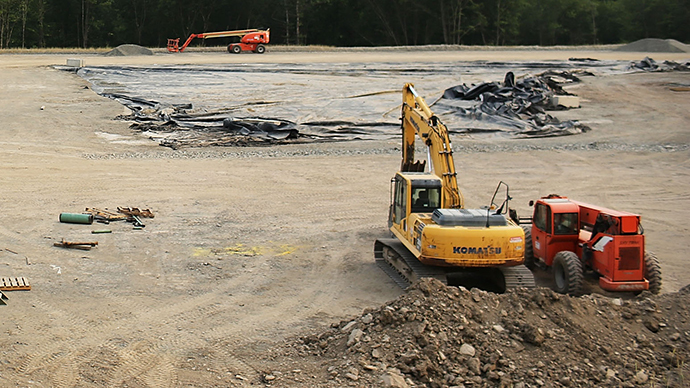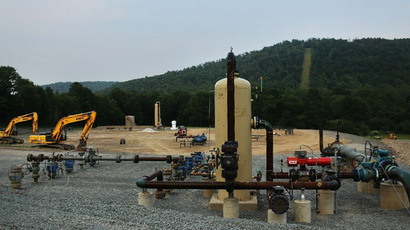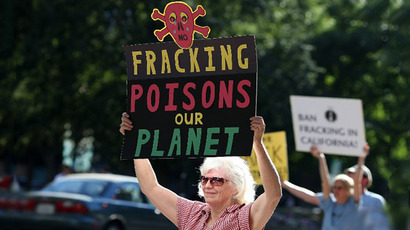Department of Energy study claims fracking is safe, contradicting previous findings

Preliminary results from a study funded by the US Department of Energy demonstrate that hydraulic fracturing has no effect on drinking water – results that contradict numerous other reports that prove the opposite.
For the past year, researchers at the DOE’s National Energy Technology Laboratory (NETL) have monitored a fracking site in western Pennsylvania, southwest of Pittsburgh. They allegedly found no evidence that the chemical-laced fluids injected into the ground made their way to the surface, the Associated Press reports.
These fluids were injected into wellbores more than 8,000 feet below the surface and were not detected above 3,000 feet. The chemical-laced fluids, whose potential health effects are hotly debated, thereby kept a considerable distance from aquifers that provide drinking water.
The study was the first time that a drilling company allowed federal researchers to inject tracers into the fracking fluid to see if it spreads. Drilling advocates are likely to hail the study as proof of the procedure’s safety, but it contradicts numerous other studies that have demonstrated the opposite.
Rob Jackson, a scientist at Duke University, warned that a single study should not serve as evidence that fracking is safe, especially since the geology and fracking practices vary across the US. He told the AP that the drilling company might have been unusually meticulous at their research site, knowing that the procedure was being closely monitored.
Jackson also explained that other aspects of the drilling process can contaminate groundwater, including poor well construction, accidental surface spills of chemicals and chemical-laced fluids, and wastewater.
The depth of the well might also have an impact on the potential effect on groundwater. Drilling at the well in western Pennsylvnia occurred at 8,000 feet below ground, with groundwater in the Marcellus Shale usually found at a depth of 300 feet.
Drilling at a fracking site in Pavillion, Wyoming, on the other hand, occurs at a depth of 1,200 feet. Groundwater in that region is acquired from depths of 800 feet, which means that the fracking site is in close proximity to drinking water. The Environmental Protection Agency in 2011 released a report concluding that chemical-laced fracking fluids contaminated the groundwater in Pavillion. But last month, the EPA dropped its plans to further investigate the preliminary findings, and instead allowed state officials – many of whom are drilling advocates – to take over the study.
Although the EPA shied away from its investigation, its initial results caused alarm and convinced environmental activists that fracking can contaminate drinking water – especially at drilling sites close to the surface.
A more recent study conducted by researchers at Duke University examined fracking sites across northeastern Pennsylvania and southern New York, where drilling usually occurs at greater depths. The researchers found that household drinking water that comes from any of the 141 wells near fracking sites has higher concentrations of methane, which is the main component of natural gas. Researchers found that 82 percent of the 141 water wells had elevated levels of methane, and that ethane concentrations were 23 times higher in drinking water at nearby homes.
“The methane, ethane and propane data, and new evidence from
hydrocarbon and helium isotopes, all suggest that drilling has
affected some homeowners’ water,” Jackson, the study’s main
author, wrote in a report.
At the fracking site in Pennsylvania, DOE scientists also discovered that one hydraulic fracture traveled 1,800 feet from the well bored. Most of the other fractures traveled just a few hundred feet. Although the 8,000-foot Pennsylvania well was deep enough to prevent the 1,800-foot fracture from having an impact on groundwater, that might not be the case with other, more shallow wells. The individual fracture was longer than the entire depth of Pavillion’s well, where drilling occurs at 1,200 feet. Scientists were unable to predict that fracture, and it remains unclear if they can be prevented.
Although chemical-laced fluids might not have escaped from the 8,000-foot well in Pennsylvania, the DOE’s preliminary findings may not be able to apply to all fracking sites, especially since other government and university studies have evidence that drilling may have contaminated drinking water.














